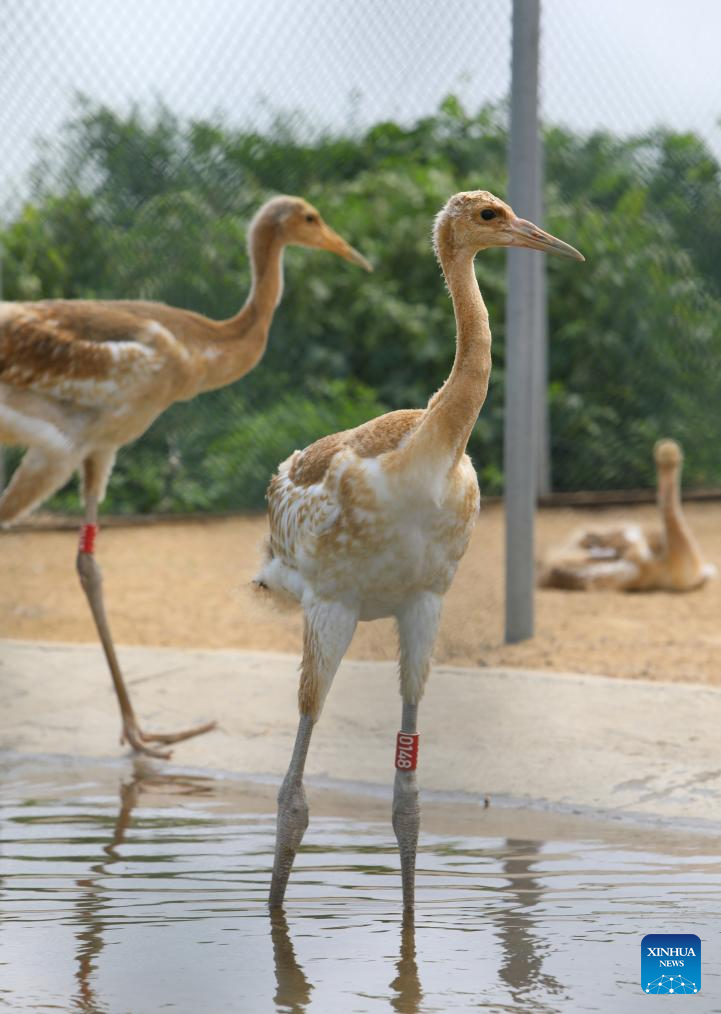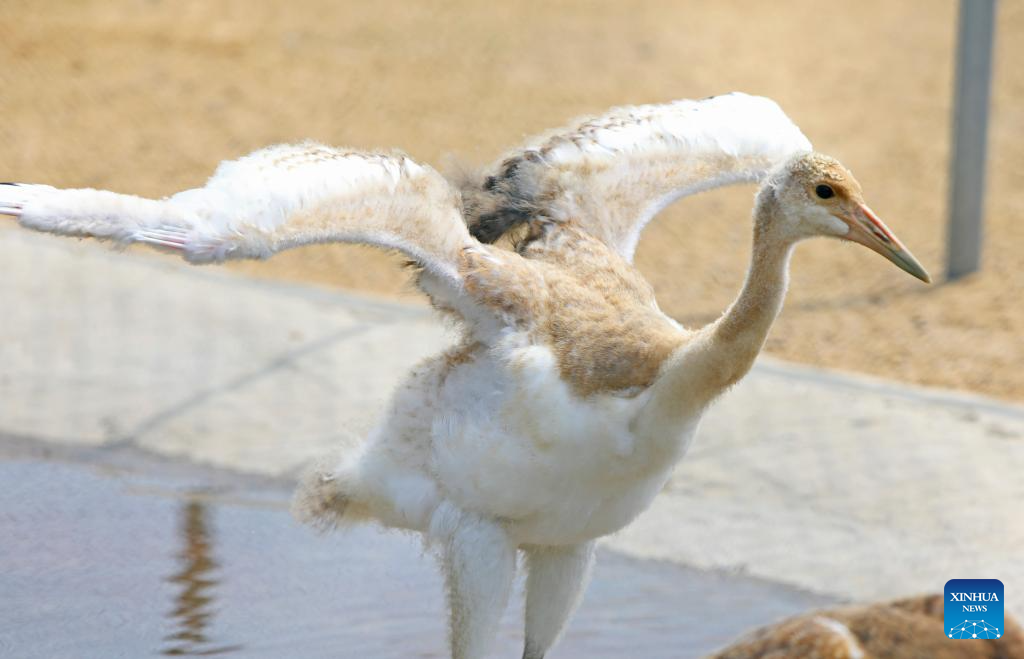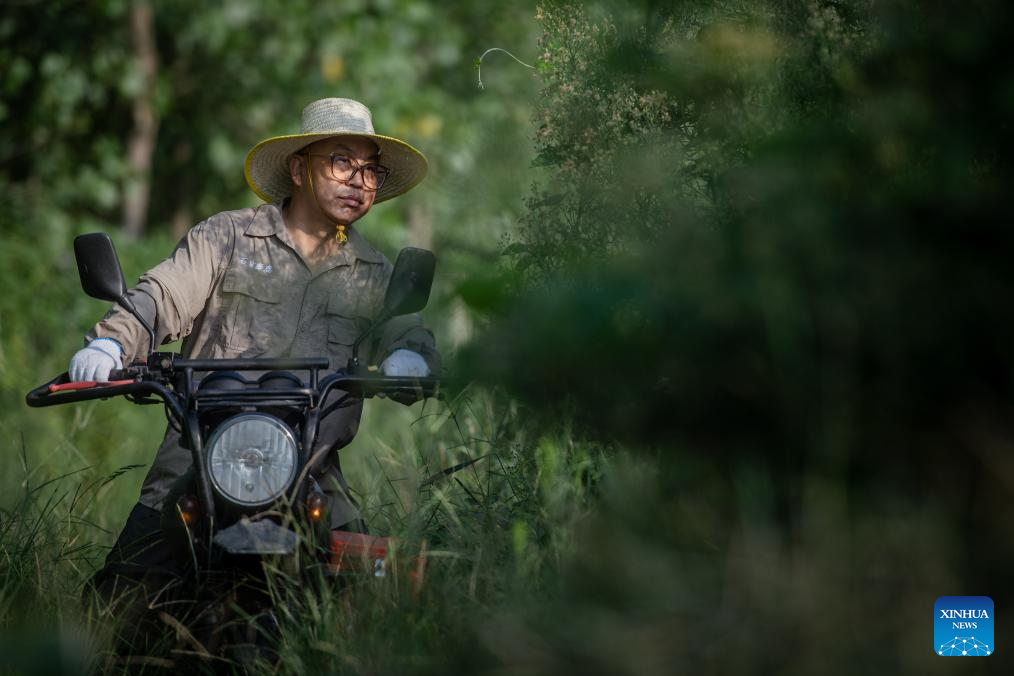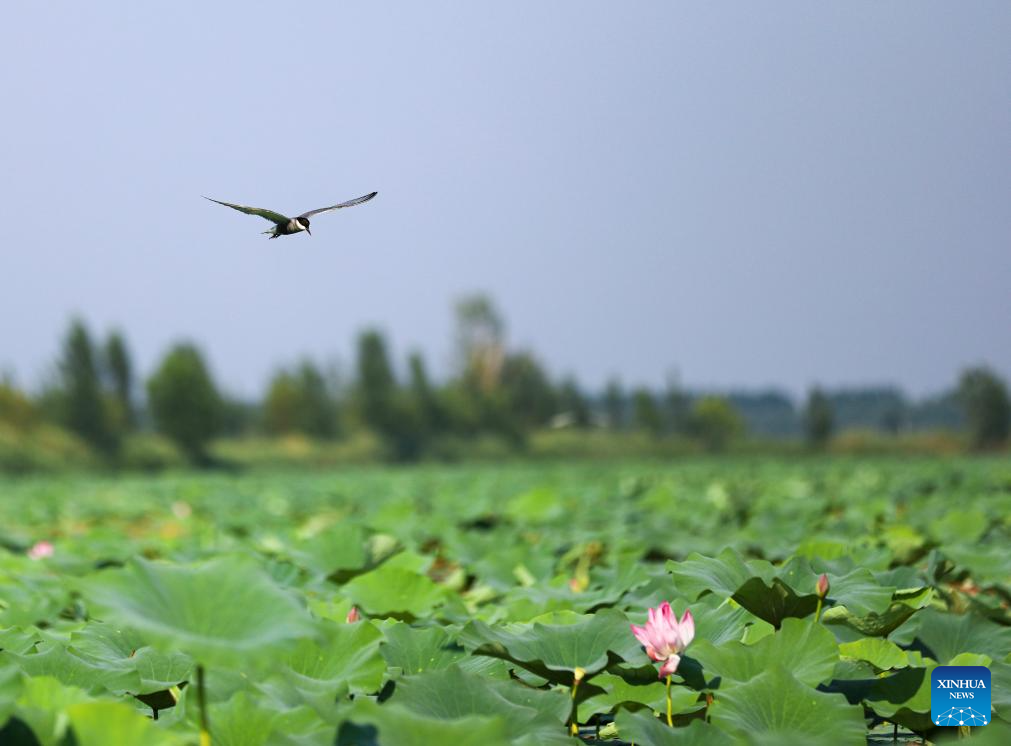China's top legislature has designated Aug. 15 as National Ecology Day. The idea that "lucid waters and lush mountains are invaluable assets" has emerged as a guiding principle in China's pursuit of green development, and green, circular and low-carbon development has become a joint endeavor across the country.
Over the past years, China has made notable achievements in ecological and environmental protection, bringing a strong sense of fulfillment and happiness to the Chinese people. Let's take a look.

Baby red-crowned cranes are pictured in a crane breeding and protection station under the Forestry and Wetland Protection Service Center in Panjin City, northeast China's Liaoning Province, Aug. 3, 2023.
The crane breeding and protection station has bred 85 baby red-crowned cranes so far this year. The baby cranes will go through wild training when they're about 60 days old. (Xinhua/Chen Wei)

A baby red-crowned crane is pictured in a crane breeding and protection station under the Forestry and Wetland Protection Service Center in Panjin City, northeast China's Liaoning Province, Aug. 3, 2023.
The crane breeding and protection station has bred 85 baby red-crowned cranes so far this year. The baby cranes will go through wild training when they're about 60 days old. (Xinhua/Chen Wei)

Baby red-crowned cranes are pictured in a crane breeding and protection station under the Forestry and Wetland Protection Service Center in Panjin City, northeast China's Liaoning Province, Aug. 3, 2023.
The crane breeding and protection station has bred 85 baby red-crowned cranes so far this year. The baby cranes will go through wild training when they're about 60 days old. (Xinhua/Chen Wei)

A baby red-crowned crane is pictured in a crane breeding and protection station under the Forestry and Wetland Protection Service Center in Panjin City, northeast China's Liaoning Province, Aug. 3, 2023.
The crane breeding and protection station has bred 85 baby red-crowned cranes so far this year. The baby cranes will go through wild training when they're about 60 days old. (Xinhua/Chen Wei)

Baby red-crowned cranes are pictured in a crane breeding and protection station under the Forestry and Wetland Protection Service Center in Panjin City, northeast China's Liaoning Province, Aug. 3, 2023.
The crane breeding and protection station has bred 85 baby red-crowned cranes so far this year. The baby cranes will go through wild training when they're about 60 days old. (Xinhua/Chen Wei)

This aerial photo taken on Aug. 9, 2023 shows flocks of wild birds like herons and egrets on the trees at a wetland in Wenting Lake of Chengwu county, Heze city, east China's Shandong Province.
In recent years, Chengwu has improved the ecological environment of local wetlands which become a paradise for wild birds. (Xinhua/Xu Suhui)

This aerial photo taken on Aug. 9, 2023 shows several wild birds on the trees at a wetland in Wenting Lake of Chengwu county, Heze city, east China's Shandong Province.
In recent years, Chengwu has improved the ecological environment of local wetlands which become a paradise for wild birds. (Xinhua/Xu Suhui)

This aerial photo taken on Aug. 9, 2023 shows herons on the trees at a wetland in Wenting Lake of Chengwu county, Heze city, east China's Shandong Province.
In recent years, Chengwu has improved the ecological environment of local wetlands which become a paradise for wild birds. (Xinhua/Xu Suhui)

This aerial photo taken on Aug. 9, 2023 shows herons on the trees at a wetland in Wenting Lake of Chengwu county, Heze city, east China's Shandong Province.
In recent years, Chengwu has improved the ecological environment of local wetlands which become a paradise for wild birds. (Xinhua/Xu Suhui)

This aerial photo taken on Aug. 9, 2023 shows herons on the trees at a wetland in Wenting Lake of Chengwu county, Heze city, east China's Shandong Province.
In recent years, Chengwu has improved the ecological environment of local wetlands which become a paradise for wild birds. (Xinhua/Xu Suhui)

This aerial photo taken on Aug. 9, 2023 shows flocks of wild birds like herons and egrets on the trees at a wetland in Wenting Lake of Chengwu county, Heze city, east China's Shandong Province.
In recent years, Chengwu has improved the ecological environment of local wetlands which become a paradise for wild birds. (Xinhua/Xu Suhui)

This aerial photo taken on Aug. 9, 2023 shows flocks of wild birds like herons and egrets on the trees at a wetland in Wenting Lake of Chengwu county, Heze city, east China's Shandong Province.
In recent years, Chengwu has improved the ecological environment of local wetlands which become a paradise for wild birds. (Xinhua/Xu Suhui)

This photo taken on Aug. 1, 2023 shows milu deer at Shishou Milu Deer National Nature Reserve in central China's Hubei Province. Milu deer at Shishou Milu Deer National Nature Reserve mate between June and August every year, during which the males fight each other for the privilege to stay together with as many females as they wish. To ensure a safe and tranquil environment for their reproduction, rangers here have been spending more time and efforts patrolling the nature reserve during this period.
After years of efforts by protectors and continuous improvement of the local ecological environment, the population of milu deer at the nature reserve has increased rapidly, nearing 2,000 to date. There are more than 10 naturally formed breeding groups in varying sizes among these milu deer, and more baby milu deer are expected to come to the world after mating season this year. (Xinhua/Wu Zhizun)

Ranger Wang Chuanjun patrols Shishou Milu Deer National Nature Reserve in central China's Hubei Province, Aug. 1, 2023. Milu deer at Shishou Milu Deer National Nature Reserve mate between June and August every year, during which the males fight each other for the privilege to stay together with as many females as they wish. To ensure a safe and tranquil environment for their reproduction, rangers here have been spending more time and efforts patrolling the nature reserve during this period.
After years of efforts by protectors and continuous improvement of the local ecological environment, the population of milu deer at the nature reserve has increased rapidly, nearing 2,000 to date. There are more than 10 naturally formed breeding groups in varying sizes among these milu deer, and more baby milu deer are expected to come to the world after mating season this year. (Xinhua/Wu Zhizun)

Ranger Wang Chuanjun patrols Shishou Milu Deer National Nature Reserve in central China's Hubei Province, Aug. 1, 2023. Milu deer at Shishou Milu Deer National Nature Reserve mate between June and August every year, during which the males fight each other for the privilege to stay together with as many females as they wish. To ensure a safe and tranquil environment for their reproduction, rangers here have been spending more time and efforts patrolling the nature reserve during this period.
After years of efforts by protectors and continuous improvement of the local ecological environment, the population of milu deer at the nature reserve has increased rapidly, nearing 2,000 to date. There are more than 10 naturally formed breeding groups in varying sizes among these milu deer, and more baby milu deer are expected to come to the world after mating season this year. (Xinhua/Wu Zhizun)

This aerial photo taken on Aug. 1, 2023 shows a male milu deer (upper right corner) chasing a herd of female ones at Shishou Milu Deer National Nature Reserve in central China's Hubei Province. Milu deer at Shishou Milu Deer National Nature Reserve mate between June and August every year, during which the males fight each other for the privilege to stay together with as many females as they wish. To ensure a safe and tranquil environment for their reproduction, rangers here have been spending more time and efforts patrolling the nature reserve during this period.
After years of efforts by protectors and continuous improvement of the local ecological environment, the population of milu deer at the nature reserve has increased rapidly, nearing 2,000 to date. There are more than 10 naturally formed breeding groups in varying sizes among these milu deer, and more baby milu deer are expected to come to the world after mating season this year. (Xinhua/Wu Zhizun)

A male milu deer chases a female one at Shishou Milu Deer National Nature Reserve in central China's Hubei Province, Aug. 1, 2023. Milu deer at Shishou Milu Deer National Nature Reserve mate between June and August every year, during which the males fight each other for the privilege to stay together with as many females as they wish. To ensure a safe and tranquil environment for their reproduction, rangers here have been spending more time and efforts patrolling the nature reserve during this period.
After years of efforts by protectors and continuous improvement of the local ecological environment, the population of milu deer at the nature reserve has increased rapidly, nearing 2,000 to date. There are more than 10 naturally formed breeding groups in varying sizes among these milu deer, and more baby milu deer are expected to come to the world after mating season this year. (Xinhua/Wu Zhizun)

Engineer Yang Tao works on an information platform system at Shishou Milu Deer National Nature Reserve in central China's Hubei Province, Aug. 2, 2023. Milu deer at Shishou Milu Deer National Nature Reserve mate between June and August every year, during which the males fight each other for the privilege to stay together with as many females as they wish. To ensure a safe and tranquil environment for their reproduction, rangers here have been spending more time and efforts patrolling the nature reserve during this period.
After years of efforts by protectors and continuous improvement of the local ecological environment, the population of milu deer at the nature reserve has increased rapidly, nearing 2,000 to date. There are more than 10 naturally formed breeding groups in varying sizes among these milu deer, and more baby milu deer are expected to come to the world after mating season this year. (Xinhua/Wu Zhizun)

This photo taken on Aug. 2, 2023 shows milu deer at Shishou Milu Deer National Nature Reserve in central China's Hubei Province. Milu deer at Shishou Milu Deer National Nature Reserve mate between June and August every year, during which the males fight each other for the privilege to stay together with as many females as they wish. To ensure a safe and tranquil environment for their reproduction, rangers here have been spending more time and efforts patrolling the nature reserve during this period.
After years of efforts by protectors and continuous improvement of the local ecological environment, the population of milu deer at the nature reserve has increased rapidly, nearing 2,000 to date. There are more than 10 naturally formed breeding groups in varying sizes among these milu deer, and more baby milu deer are expected to come to the world after mating season this year. (Xinhua/Wu Zhizun)

Ranger Wang Chuanjun patrols Shishou Milu Deer National Nature Reserve in central China's Hubei Province, Aug. 1, 2023. Milu deer at Shishou Milu Deer National Nature Reserve mate between June and August every year, during which the males fight each other for the privilege to stay together with as many females as they wish. To ensure a safe and tranquil environment for their reproduction, rangers here have been spending more time and efforts patrolling the nature reserve during this period.
After years of efforts by protectors and continuous improvement of the local ecological environment, the population of milu deer at the nature reserve has increased rapidly, nearing 2,000 to date. There are more than 10 naturally formed breeding groups in varying sizes among these milu deer, and more baby milu deer are expected to come to the world after mating season this year. (Xinhua/Wu Zhizun)

Two male milu deer fight at Shishou Milu Deer National Nature Reserve in central China's Hubei Province, Aug. 1, 2023. Milu deer at Shishou Milu Deer National Nature Reserve mate between June and August every year, during which the males fight each other for the privilege to stay together with as many females as they wish. To ensure a safe and tranquil environment for their reproduction, rangers here have been spending more time and efforts patrolling the nature reserve during this period.
After years of efforts by protectors and continuous improvement of the local ecological environment, the population of milu deer at the nature reserve has increased rapidly, nearing 2,000 to date. There are more than 10 naturally formed breeding groups in varying sizes among these milu deer, and more baby milu deer are expected to come to the world after mating season this year. (Xinhua/Wu Zhizun)

This photo taken on July 28, 2023 shows a shrike on a tree branch in Chengguan District of Lhasa, southwest China's Tibet Autonomous Region.
Trees at parks and gardens in Lhasa have been home for birds. In recent years, various measures have been taken to improve the urban and rural environment in Lhasa, which becomes a green and eco-friendly city. (Xinhua/Zhang Rufeng)

This photo taken on July 28, 2023 shows a shrike on a tree branch in Chengguan District of Lhasa, southwest China's Tibet Autonomous Region.
Trees at parks and gardens in Lhasa have been home for birds. In recent years, various measures have been taken to improve the urban and rural environment in Lhasa, which becomes a green and eco-friendly city. (Xinhua/Zhang Rufeng)

This photo taken on July 28, 2023 shows a shrike flying over the sky in Chengguan District of Lhasa, southwest China's Tibet Autonomous Region.
Trees at parks and gardens in Lhasa have been home for birds. In recent years, various measures have been taken to improve the urban and rural environment in Lhasa, which becomes a green and eco-friendly city. (Xinhua/Zhang Rufeng)

This photo taken on July 28, 2023 shows a shrike (right) and a baby bird on a tree branch in Chengguan District of Lhasa, southwest China's Tibet Autonomous Region.
Trees at parks and gardens in Lhasa have been home for birds. In recent years, various measures have been taken to improve the urban and rural environment in Lhasa, which becomes a green and eco-friendly city. (Xinhua/Zhang Rufeng)

A mallard duck flies over the Lhalu wetland in Lhasa, southwest China's Tibet Autonomous Region, July 23, 2023.
The Lhalu wetland national nature reserve, with an average altitude of 3,645 meters, covers an area of 12.2 square kilometers. The wetland's ecological conditions improved as conservation efforts were stepped up. (Xinhua/Zhang Rufeng)

An egret flies over the Lhalu wetland in Lhasa, southwest China's Tibet Autonomous Region, July 23, 2023.
The Lhalu wetland national nature reserve, with an average altitude of 3,645 meters, covers an area of 12.2 square kilometers. The wetland's ecological conditions improved as conservation efforts were stepped up. (Xinhua/Zhang Rufeng)

Birds are pictured at Baiyangdian Lake in Xiong'an New Area, north China's Hebei Province, July 19, 2023. The Baiyangdian Lake, the largest wetland ecosystem in northern China, is located in Xiong'an. After the establishment of the new area, the water quality in Baiyangdian has improved from below Level V, the lowest of China's five-tier water assessment system, to Level III. The area of Baiyangdian has been restored from about 170 square kilometers to about 290 square kilometers, and the water level in the lake area has remained stable at about 7.2 meters. (Xinhua/Hao Jianwei)

A bird is pictured at Baiyangdian Lake in Xiong'an New Area, north China's Hebei Province, July 19, 2023. The Baiyangdian Lake, the largest wetland ecosystem in northern China, is located in Xiong'an. After the establishment of the new area, the water quality in Baiyangdian has improved from below Level V, the lowest of China's five-tier water assessment system, to Level III. The area of Baiyangdian has been restored from about 170 square kilometers to about 290 square kilometers, and the water level in the lake area has remained stable at about 7.2 meters. (Xinhua/Hao Jianwei)

A bird perches on a metal pole at Baiyangdian Lake in Xiong'an New Area, north China's Hebei Province, July 19, 2023. The Baiyangdian Lake, the largest wetland ecosystem in northern China, is located in Xiong'an. After the establishment of the new area, the water quality in Baiyangdian has improved from below Level V, the lowest of China's five-tier water assessment system, to Level III. The area of Baiyangdian has been restored from about 170 square kilometers to about 290 square kilometers, and the water level in the lake area has remained stable at about 7.2 meters. (Xinhua/Gao Junfeng)

A bird flies over Baiyangdian Lake in Xiong'an New Area, north China's Hebei Province, July 19, 2023. The Baiyangdian Lake, the largest wetland ecosystem in northern China, is located in Xiong'an. After the establishment of the new area, the water quality in Baiyangdian has improved from below Level V, the lowest of China's five-tier water assessment system, to Level III. The area of Baiyangdian has been restored from about 170 square kilometers to about 290 square kilometers, and the water level in the lake area has remained stable at about 7.2 meters. (Xinhua/Gao Junfeng)

A bird flies over Baiyangdian Lake in Xiong'an New Area, north China's Hebei Province, July 19, 2023. The Baiyangdian Lake, the largest wetland ecosystem in northern China, is located in Xiong'an. After the establishment of the new area, the water quality in Baiyangdian has improved from below Level V, the lowest of China's five-tier water assessment system, to Level III. The area of Baiyangdian has been restored from about 170 square kilometers to about 290 square kilometers, and the water level in the lake area has remained stable at about 7.2 meters. (Xinhua/Hao Jianwei)

People have fun at the Tao'erhe National Wetland Park in Ulanhot City, north China's Inner Mongolia Autonomous Region, Aug. 13, 2023. (Xinhua/Peng Yuan)

A sightseeing electric vehicle moves at the Tao'erhe National Wetland Park in Ulanhot City, north China's Inner Mongolia Autonomous Region, Aug. 13, 2023. (Xinhua/Peng Yuan)

A child plays at the Tao'erhe National Wetland Park in Ulanhot City, north China's Inner Mongolia Autonomous Region, Aug. 13, 2023. (Xinhua/Peng Yuan)



